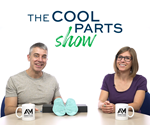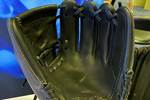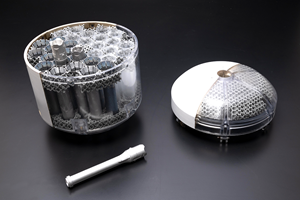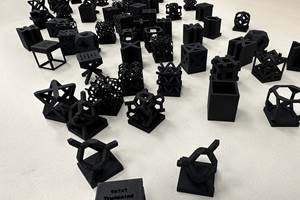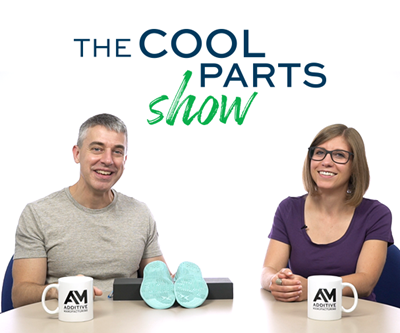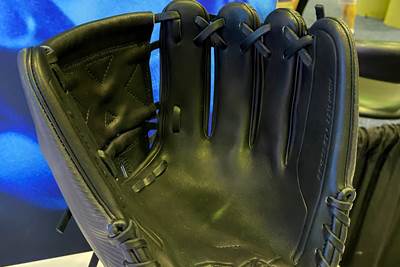Engineering firm General Lattice was one of the partners in a project led by Wilson Sporting Goods to see whether flexible geometries achieved through 3D printing can match the feel and performance expected of a standard basketball. These two companies plus EOS and DyeMansion, succeeded at creating an “airless” basketball delivering a standard basketball’s bounce and heft through 3D printed polymer structures alone. On this bonus episode of The Cool Parts Show, we talk about the airless basketball and what this success means. | This episode of The Cool Parts Show brought to you by Carpenter Additive
The Cool Parts Show is a video series from Additive Manufacturing Media that explores the what, how and why of unusual 3D printed parts. Watch more here.
Have a cool part to share? Email us.
Related Resources
- Design and engineering firm General Lattice
- Our full-length episode of The Cool Parts Show on General Lattice’s application of digital materials to helmet padding
- Sporting goods covered on The Cool Parts Show and in other video
Transcript
Peter Zelinski 00:00
Hi, I'm Pete.
Stephanie Hendrixson 00:10
I'm Stephanie.
Peter Zelinski 00:10
Welcome to a bonus episode of The Cool Parts Show.
Stephanie Hendrixson 00:13
We recently did an episode with a company called General Lattice, they designed some 3D printed custom helmet pads for us. That's episode 62. You can find it linked in the show description. But, when we visited them for that episode, we wanted to ask them about something else, this project that you may have seen at a recent tradeshow or on social media, this 3D printed airless basketball prototype.
Peter Zelinski 00:35
So this was the idea of Wilson Sporting Goods. Wilson came to General Lattice for help with exploring an idea. Is it possible to use flexible 3D printed lattice forms to create an airless basketball?
Stephanie Hendrixson 00:51
So this is right up their alley. General Lattice is a digital materials company. So they specialize in manipulating geometries to make materials do the things that you need them to do. They worked with some other partners on this project. EOS provided the 3D printing through selective laser sintering. And DyeMansion did the finishing. But they were all working together on this problem. How do you engineer an airless basketball that's going to be 3D printable, and also look, behave the same as a standard basketball when you're dribbling, passing, shooting.
Peter Zelinski 01:21
So, here's the thing. So, on one level, this is kind of a novelty. So, professional basketball is not anywhere close to adopting an airless ball. But on another level, this is a significant area of innovation, technical exploration, the question of whether you can use digital materials, 3D printed engineered flexible structures to precisely replicate the bounce, the performance, the resilience, the heft of a real basketball, and they did it.
Stephanie Hendrixson 01:56
We talked to Marek Moffett and Nick Florek, of General Lattice about this, here's what they had to say.
Nick Florek 02:01
Wilson had been trying to work on designing an airless basketball for quite some time and had run into a number of issues from finding the right printer and material to actually executing the design. So they had a concept for the lattice structure that they wanted to use within within the basketball, they had a pretty good idea of what that shape and structure should be. But they wanted to create that structure balanced across the hemisphere. And so to create a lattice structure that is hemispherically equal is a pretty difficult trick to do from a geometric point of view, just from CAD tools alone. And so where General Lattice was able to support was from some computational design point of view, basically writing some tools and some code that made that process easy and made it parametric. So basically, Wilson guiding General Lattice to isolate the particular parameters that we knew were going to change throughout the iteration process. Mass was a huge consideration, right? Like we needed it to feel in your hands like it was the same weight as a ball. And so tuning the lattice to to make sure that we didn't go over, under the mass was a major consideration. Also the stiffness of the ball. So working through different base material options, lattice structure, in terms of how do we optimize stiffness with the different variables of the strut, diameter and size of the actual unit cell to really hone that in to where it bounced the same as a game ball for the NBA and actually was the same mass.
Marek Moffett
We were able to parameterize the script in such a way that we knew which elements needed to be tweaked quickly. And we were able to with EOS print really quickly, ultimately getting physical results from Wilson's test facilities. And so we were quickly able to iterate through many versions of the ball and send it to Wilson's testing facilities where they would do rebound testing, durability testing, and wobble testing.
Peter Zelinski 04:10
So it's really interesting the design that they came to with their iteration, right. So outer layer, we can see these hexagons, and then you look through them and there is this second inner sphere, this different layer of hexagons, these two spherical layers connected by these radial posts.
Stephanie Hendrixson 04:31
Yeah, it's a really cool looking design, but it's also super functional, like tuning all of those different variables is how they got the weight of the ball right? How they got the rebound, right? How they got it to behave like we would expect a basketball to. But as we said at the beginning of the episode, your favorite NBA team is probably not going to be playing with a 3D printed airless basketball anytime soon. Instead, this is a really good illustration of digital materials and the potential possibilities for them. So General Lattice and their project partners see this as a good use case for how you can reimagine something that already exists in the world, and use geometry, use these different design iterations, use 3D printing to make something that works exactly the same way. So they hope that people look at this basketball and start to imagine what they might be able to do.
Nick Florek 05:18
Well, we're excited that the ball shows is that you can replace an existing material with a digital material and still yield the same response, right. And so our hope is that this really showcases an example of a digital material being integrated into a product and helps people think, you know, where can they go with digital materials, right?
Marek Moffett
I think the airless prototype really demonstrates for digital materials, a great example of just how to start thinking about traditional applications. And you know, could they be made a different way? General Lattice's ultimate goal is to have an average design engineer, someone who maybe is not 3D printing or using digital manufacturing to say, Oh, wow, these properties are outperforming or very similar to what I'm doing today. Can it be done another way?
Nick Florek
I think an airless basketball with a lattice isn't necessarily people's first thought of what additional material can do. And so, to us, this just really kind of helps people open their thought to, to where digital materials can go in terms of replacing existing materials. And, again, that's really core to what we are trying to do here as a company is advance traditional materials beyond what they are today, through the use of geometry.
Peter Zelinski 06:35
Be sure to check out our original full length episode about digital materials as a replacement for foam padding in protective gear. And believe it or not, we've actually done a number of episodes of The Cool Parts Show about sporting goods. So we will assemble those together and include a link in the show description.
Stephanie Hendrixson 06:54
And as a reminder, we've recently launched The Cool Parts Show All Access. It's a free subscription for our fans. And if you join you'll get early access to episodes, behind the scenes content, candid photos, extra interview clips, all kinds of cool stuff that's available now at thecoolpartsshow.com
Peter Zelinski 07:10
Thanks for watching.
Related Content
3D Printed Lattice for Mars Sample Return Crash Landing: The Cool Parts Show Bonus
NASA Jet Propulsion Laboratory employs laser powder bed fusion additive manufacturing plus chemical etching to create strong, lightweight lattice structures optimized to protect rock samples from Mars during their violent arrival on earth.
Read MoreVixiv Developing AI Alternative to Generative Design
Newly opened Ohio facility is where geometric cells are made and tested to inform the machine learning system that will “know,” without computation, what 3D printed form satisfies a given set of needs.
Read MoreImplicit Modeling for Additive Manufacturing
Some software tools now use this modeling strategy as opposed to explicit methods of representing geometry. Here’s how it works, and why it matters for additive manufacturing.
Read More3MF File Format for Additive Manufacturing: More Than Geometry
The file format offers a less data-intensive way of recording part geometry, as well as details about build preparation, material, process and more.
Read MoreRead Next
Shoe Insoles Precisely Tailored to Individual Feet: The Cool Parts Show #4
This episode of The Cool Parts Show looks at how 3D printing will deliver tailored products. Scanning feet for their geometry and pressure enables Aetrex and EOS to manufacture insoles that are unique to individual wearers.
Read More3D Printed Baseball Mitt Inserts Are Ready for the Big Leagues
Fast Radius was able to use Carbon’s DLS system for both prototyping and production of 3D printed, fatigue-resistant inserts for Rawlings’ REV1X baseball glove.
Read MoreProfilometry-Based Indentation Plastometry (PIP) as an Alternative to Standard Tensile Testing
UK-based Plastometrex offers a benchtop testing device utilizing PIP to quickly and easily analyze the yield strength, tensile strength and uniform elongation of samples and even printed parts. The solution is particularly useful for additive manufacturing.
Read More


